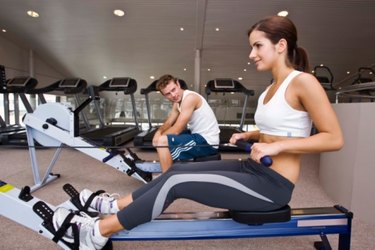
Even otherwise healthy adults need regular cardio exercise to help maintain health and reduce risk of chronic disease, as explained in the American College of Sports Medicine Physical Activity & Public Health Guidelines.
Both indoor rowers and elliptical trainers give you a way of meeting the ACSM recommendations for physical activity. Which one you use, in the end, boils down to simple preference. Which machine offers more of what you're looking for?
Video of the Day
Video of the Day
Learning Curve
Even though most elliptical trainers look like something that just beamed down from a spaceship, they're relatively easy to use. Just put your feet in the pedals and move as if you were running or walking. Grab the handles and swing your arms back and forth, too, for an upper-body workout that challenges your cardiovascular system even more.
Proper technique on a rowing machine, however, isn't quite so intuitive. You need at least one session with a competent trainer or good training video to learn proper stroke motion, instead of the scoot-back-and-forth technique most exercisers default to. See Resources for a link to a training video on how to properly use a rowing machine.
Weight-Bearing
If you have osteoporosis, weight-bearing exercise like pedaling an elliptical trainer can slow mineral loss in the bones of your legs, hips and lower spine, according to "Exercising With Osteoporosis: Stay Active the Safe Way," published on MayoClinic.com. Rowing machines don't offer this benefit, since they aren't a weight-bearing form of exercise, but rowers do help strengthen your back, another frequently recommended treatment strategy for combating and preventing osteoporosis.
Other Benefits
Doing at least 30 minutes of aerobic activity each day helps you live a longer, healthier, more independent life, as published in "Aerobic Exercise: Top 10 Reasons to get Physical" on MayoClinic.com. Other benefits of regular aerobic exercise include a stronger cardiovascular system, improved mood, better stamina and a stronger immune system.
Muscles Worked
Both elliptical trainers and rowing machines let you strengthen your upper body and lower body together. But rowing machines are better suited to strengthening your core, which is responsible for holding your torso straight throughout each stroke, than the elliptical trainer.
The downside of the rowing machine is that it offers very little chest and triceps involvement. Although an elliptical trainer should never be mistaken for a strength-training tool, it does offer some triceps and chest involvement if you push vigorously against the handlebars as you pedal.
Cost
Because rowing machines are mechanically simpler than elliptical trainers, your odds of getting a low-end piece of equipment that holds up to regular use are better with a rower than an elliptical trainer. But low-end rowers will have some of the same problems a low-end elliptical trainer presents: flimsy construction, a loud drive mechanism and less-than-smooth motion.
A quality rowing machine can cost between $600 and $800 as of 2010, according to the Men's Total Fitness rowing machine buyer's guide. Decent elliptical trainers start in the same approximate price range, although most ellipticals dubbed as "quality" models in expert reviews cost $1,000 or more.